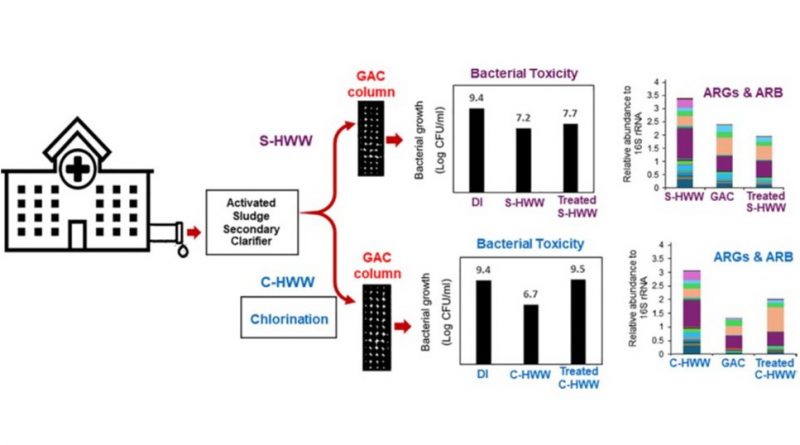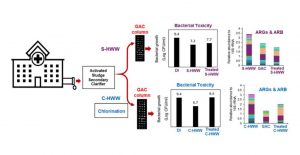Removal of antibiotics, bacterial toxicity, and occurrence of antibiotic resistance genes in secondary hospital effluents treated with granular activated carbon and the impact of preceding chlorination
Removal of antibiotics, bacterial toxicity, and occurrence of antibiotic resistance genes in secondary hospital effluents treated with granular activated carbon and the impact of preceding chlorination
การกำจัดยาปฏิชีวนะ ความเป็นพิษต่อแบคทีเรีย และการเกิดยีนต้านทานยาปฏิชีวนะในน้ำทิ้งขั้นทุติยภูมิของโรงพยาบาลที่ผ่านการบำบัดด้วยถ่านกัมมันต์แบบเม็ด และผลของคลอรีนใช้คลอรีนก่อนหน้า
This comprehensive investigation highlighted the complex adsorption behaviors of antibiotics onto granular activated carbon (GAC), the effectiveness of this adsorption in reducing bacterial toxicity, and the reduction of antibiotic resistance genes (ARGs) and antibiotic resistant bacteria (ARB) in hospital wastewater (HWW) effluents. Six GACs were characterized for their physicochemical properties, and their ability to adsorb six antibiotics in the background matrix of actual HWW was evaluated. Coconut shell-derived GAC (Co-U), which had the highest hydrophobicity and lowest content of oxygen-containing acidic functional groups, demonstrated the highest adsorption capacities for the tested antibiotics. Bacterial toxicity tests revealed that GACs could eliminate the bacterial toxicity from antibiotic intermediates present in chlorinated HWW. By contrast, the bacterial toxicity could not be removed by GACs in non-chlorinated HWW due to the greater presence of intermediate components identified by LC-MS/MS. The intraparticle diffusion coefficient of antibiotics adsorbed onto Co-U could be calculated by adsorption kinetics derived from the linear driving force model and the homogenous intraparticle diffusion model associated with the linear adsorption isotherms (0–150 μg/L). Meropenem and sulfamethoxazole exhibited the highest adsorption capacities in a single-solute solution compared to penicillin G, ampicillin, cetazidime, and ciprofloxacin. However, the greater adsorption capacities of meropenem and sulfamethoxazole disappeared in mixed-solute solutions, indicating the lowest adsorption competition. GAC can eliminate most ARGs while also promoting the growth of some ARB. Chlorination (free chlorine residues at 0.5 mg Cl2/L) did not significantly affect the overall composition of ARGs and ARB in HWW. However, the accumulation of ARGs and ARB on GAC in fixed bed columns was lower in chlorinated HWW than in non-chlorinated HWW due to an increase in the adsorption of intermediates.
การศึกษาในองค์รวมชิ้นนี้ทำให้เห็นพฤติกรรมการดูดซึมที่ซับซ้อนของยาปฏิชีวนะบนเม็ดถ่านกัมมันต์ (GAC) ซึ่งช่วยลดความเป็นพิษต่อแบคทีเรีย ลดยีนดื้อยาปฏิชีวนะ (ARG) และแบคทีเรียดื้อยาปฏิชีวนะ (ARB) ในน้ำเสียของโรงพยาบาล (HWW) โดยทำการทดสอบคุณสมบัติเฉพาะทางเคมีกายภาพ และความสามารถในการดูดซับยาปฏิชีวนะหกชนิดในน้ำเสียจริงของโรงพยาบาล ซึ่งเม็ดถ่านกัมมันต์ที่ทำจากกะลามะพร้าว (Co-U) ที่มีความไม่ชอบน้ำสูงที่สุดและมีกลุ่มฟังก์ชันที่เป็นกรดที่มีออกซิเจนเป็นตัวประกอบน้อยที่สุดพบว่าสามารถดูดซับยาปฏิชีวนะได้มากที่สุด และการทดสอบความเป็นพิษของแบคทีเรียพบว่าเม็ดถ่านกัมมันต์สามารถกำจัดความเป็นพิษต่อแบคทีเรียของสารมัธยันตร์ของยาปฏิชีวนะที่ทำปฏิกริยากับน้ำเสียที่มีคลอรีนได้ ในทางตรงข้ามกันแต่ความเป็นพิษต่อแบคทีเรียไม่สามารถถูกกำจัดได้ด้วยถ่านกัมมันต์ในน้ำเสียที่ไม่มีคลอรีน เนื่องจากมีสารมัธยันต์เป็นจำนวนมากหลงเหลืออยู่สอดคล้องกับการวิเคราะห์ด้วย LC-MS/MS ซึ่งค่าสัมประสิทธิ์การแพร่กระจายของยาปฏิชีวนะภายในอนุภาคของ Co-U สามารถคำนวณได้โดยจลนพลศาสตร์ของการดูดซับจากแบบจำลอง linear driving force และแบบจำลอง homogenous intraparticle diffusion ที่เกี่ยวกับความสัมพันธ์เชิงเส้น linear adsorption isotherms (0–150 ไมโครกรัม/ลิตร) จากผลการทดลองพบว่าเมอโรพีเนม (Meropenem ) และซัลฟาเมทอกซาโซน (sulfamethoxazole) มีความสามารถในการดูดซับสูงสุดในสารละลายเดี่ยว (single-solute solution) เมื่อเปรียบเทียบกับเพนิซิลลิน จี (penicillin G), แอมพิซิลลิน (ampicillin), เซฟตาซิดิม (cetazidime) และไซโปรฟลอกซาซิน(ciprofloxacin ) อย่างไรก็ตามความสามารถในการถูกดูดซับที่มากของเมอโรพีเนมและซัลฟาเมทอกซาโซนหายไปในสารละลายผสม (mixed-solute solutions) แสดงให้เห็นว่ายาปฏิชีวนะสองชนิดนี้มีความสามารถในการแข่งขันดูดซับต่ำ ถ่านกัมมันต์สามารถกำจัดยีนต้านทานยาปฏิชีวนะได้เป็นส่วนมาก ในขณะเดียวกันก็ส่งเสริมการเติบโตของแบคทีเรียดื้อยาปฏิชีวนะบางชนิดด้วย การใช้คลอรีน (คลอรีนคงเหลืออิสระ 0.5 mg Cl2/L) ไม่ส่งผลในการเปลี่ยนแปลงองค์ประกอบของยีนดื้อยาและเชื้อดื้อยาปฏิชีวนะในน้ำเสียของโรงพยาบาล อย่างไรก็ตามการสะสมของยีนดื้อยาปฏิชีวนะและแบคทีเรียดื้อยาปฏิชีวนะบนเม็ดถ่านกัมมันต์ในคอลัมน์แบบ fixed bed ของน้ำเสียโรงพยาบาลที่ผ่านกระบวนการคลอรีนมีค่าต่ำกว่าน้ำเสียที่ไม่ผ่านกระบวนการคลอรีน เนื่องจากการดูดซับของสารมัธยันตร์ที่มีประสิทธิภาพมากกว่า
สนับสนุน SDGs เป้าหมายที่ 6 : การจัดการน้ำและสุขาภิบาล ข้อย่อย 6.3 ปรับปรุงคุณภาพน้ำ โดยการลดมลพิษ ขจัดการทิ้งขยะและลดการปล่อยสารเคมีอันตรายและวัสถุอันตราย ลดสัดส่วนน้ำเสียที่ไม่ผ่านกระบวนการลงครึ่งหนึ่ง และเพิ่มการนำกลับมาใช้ใหม่และการใช้ซ้ำที่ปลอดภัยอย่างยั่งยืนทั่วโลก ภายในปี 2573


